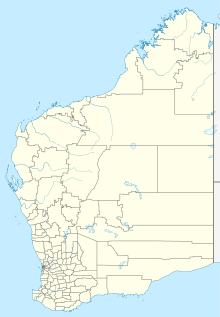Paraburdoo mine
 The Paraburdoo mine in October 2011. | |
| Location | |
|---|---|
| Location | Shire of Ashburton, Pilbara |
| State | Western Australia |
| Country | Australia |
| Coordinates | 23°13′36″S 117°36′30″E / 23.226780°S 117.608200°E |
| Production | |
| Products | Iron ore |
| Production | 20 million tonnes/annum |
| History | |
| Opened | 1972 |
| Owner | |
| Company | Rio Tinto Iron Ore |
| Website | Rio Tinto Iron Ore website |
 | |
The Paraburdoo mine is an iron ore mine located in the Pilbara region of Western Australia, near Paraburdoo.[1]
The mine is owned and operated by Rio Tinto Iron Ore, and is one of twelve iron ore mines the company operates in the Pilbara.[2][3] In 2009, the combined Pilbara operations produced 202 million tonnes of iron ore, a 15% increase over 2008.[4] The Pilbara operations accounted for almost 13% of the world's 2009 iron ore production of 1.59 billion tonnes.[5][6]
The Hamersley Range, where the mine is located, contains 80% of all identified iron ore reserves in Australia and is one of the world's major iron ore provinces.[7]
Overview
[edit]
Rio Tinto's iron ore operations in the Pilbara began in 1966.[2] The mine itself began operations in 1972. The combined production capacity of the Paraburdoo, Eastern Range and Channar mines is 20 million tonnes of iron ore. The ore is processed on site before being loaded onto rail.[8] Ore from Paraburdoo, like Brockman, Mount Tom Price, Channar, Eastern Range, Marandoo and Yandicoogina are transported as lump and fines ore product from the mines to Dampier via rail. Before being loaded onto ships for export, the product is blended and rescreened. The maximum size for the lumps is 31.5 mm, while the fines are at a maximum of 6.3 mm.[9]
Ore from the mine is then transported to the coast through the Hamersley & Robe River railway, where it is loaded onto ships.[10]
The mine's workforce lives in Paraburdoo.[8] In 2009, the combined operations of Paraburdoo, Channar and Eastern Range employed 1,081 people, a decrease compared to 2008 when it employed 1,324.[11]
The mine is owned by Hamersley Iron Pty Ltd, a fully owned subsidiary of Rio Tinto, which owns six mines in the Pilbara, including Paraburdoo, and partly owns two more mines in the region.[11]
References
[edit]- ^ MINEDEX website: Paraburdoo search result Archived 2008-09-11 at the Wayback Machine accessed: 6 November 2010
- ^ a b Pilbara Archived 2013-10-21 at the Wayback Machine Rio Tinto Iron Ore website, accessed: 6 November 2010
- ^ Mining Archived 2010-06-12 at the Wayback Machine Rio Tinto Iron Ore website, accessed: 6 November 2010
- ^ Preparing for the future Archived 2011-07-15 at the Wayback Machine Rio Tinto presentation, published: 23 March 2010, accessed: 7 November 2010
- ^ Global iron-ore production falls 6,2% in 2009 - Unctad report miningweekly.com, published: 30 July 2010, accessed: 7 November 2010
- ^ Production of iron ore fell in 2009, but shipments continued to increase, report says[permanent dead link] UNCTAD website, published: 30 July 2010, accessed: 7 November 2010
- ^ Iron fact sheet - Australian Resources and Deposits Archived 2011-02-18 at the Wayback Machine Geoscience Australia website, accessed: 7 November 2010
- ^ a b Paraburdoo mine Archived 2011-07-15 at the Wayback Machine Rio Tinto Iron Ore website, accessed: 6 November 2010
- ^ Iron fact sheet - Mining Archived 2011-02-18 at the Wayback Machine Geoscience Australia website, accessed: 7 November 2010
- ^ Rail Archived 2013-07-01 at the Wayback Machine Rio Tinto Iron Ore website, accessed: 6 November 2010
- ^ a b Western Australian Mineral and Petroleum Statistic Digest 2009 Department of Mines and Petroleum website, accessed: 8 November 2010

